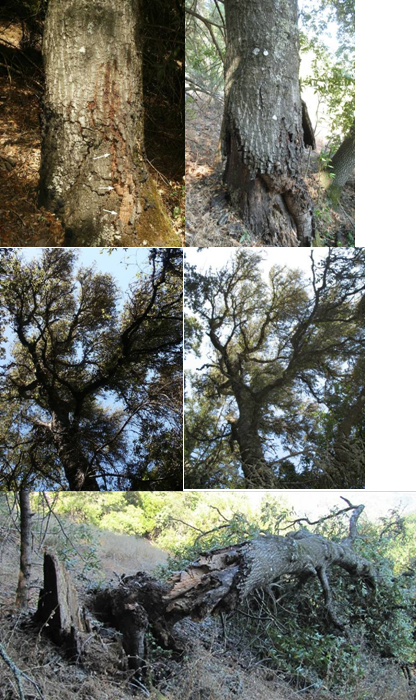
Several general patterns of tree decline can be seen in oaks with P. ramorum cankers. Tanoaks most commonly follow the first pattern of decline ("sudden" death), but sometimes follow the other patterns.
"Sudden" oak death: Trees develop large cankers and become mostly or entirely girdled within 1 to 2 years. Water transport to the tree canopy is disrupted by the effects of P. ramorum infections(Parke and others 2007) and secondary agents on the outer sapwood. This eventually induces severe water stress in the tree canopy. The canopy may appear dull or off-color just before leaves undergo a rapid change from green to brown. These color changes occur within a few weeks to months, especially during periods of warm weather. The tree canopy generally shows no obvious thinning before it turns brown and dies. The name "sudden oak death" is based on this disease pattern, but trees have typically been infected 6 months to several years before they reach this stage.
Slow decline: Trees have fewer, less extensive, and/or slower-spreading cankers. After several years, the canopy may begin to progressively thin and decline (fig. 1-15). Affected trees may survive for many years, sometimes maintained by only small areas of healthy callus on a mostly girdled trunk. Death may occur either through a "sudden" drying of the canopy or green failure of the trunk(below). Cankers are occasionally colonized by fungi such as Stereum species, which primarily decay dead wood and are less aggressive than most of the wood decay fungi noted above.
Green failure: Oaks with large trunk cankers that are extensively decayed by A. thouarsianum, Phellinus gilvus, or other fungi may fail (break) while the top is green (fig. 1-15). Failure may occur in trees with full canopies or in trees with extensive canopy thinning. SGreen failures associated with SOD occur more commonly in coast live oak than in tanoak. Major branch and trunk failures typically result in tree death. If failure occurs in one of several trunks or main branches and decay is extensive, the remaining live portions may decline or fail within a few years. Some failed trees resprout vigorously from the stump and may begin to form a new canopy. Factors associated with tree failure are discussed further in 2.2.3 What is the Failure Potential of SOD-Affected Trees?— and 3.3 Monitoring Oaks with SOD to Assess Survival and Failure Potential.

Figure 1-15—This coast live oak was almost entirely girdled by Phytophthora ramorum cankers in 2000. Only a narrow strip of callus tissue (top: right side of trunk; left, 2004, right, 2009) connected the tree's canopy to its root system for much of the following decade. The canopy thinned and showed significant dieback, but foliage remained green (middle: left, 2004, right, 2009). Although sapwood decay was extensive for many years, the tree did not fail until September 2010 (bottom). The only sound wood at the point of failure was a small strip of sapwood associated with the callused area. Leaves were green at the time of failure.